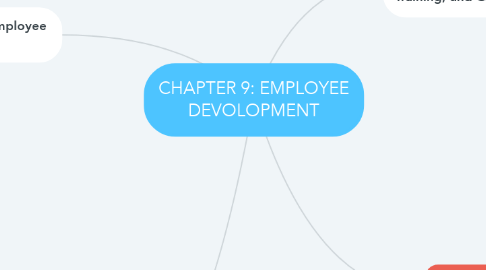
1. Approaches to Employee Development
1.1. Formal education programs:
1.1.1. include off-site and on-site programs designed specifically for the company’s employees, short courses offered by consultants or universities, executive MBA programs, and university programs in which participants live at the university while taking classes
1.2. Assessment
1.2.1. involves collecting information and providing feedback to employees about their behavior, communication style, or skills.30 The employees, their peers, managers, and customers may provide information. Assessments are used for several reasons
1.3. JOB EXPERIENCES
1.3.1. job assignments
1.3.2. interpersonal relationships
1.3.3. type of transactions
1.4. INTERPERSONAL RELATIONSHIPS
1.4.1. Employees can also develop skills and increase their knowledge about the company and its customers by interacting with a more experienced organization member. Mentoring and coaching are two types ofcinterpersonal relationships that are used to develop employees: mentoring, coaching
2. Special Issues in Employee
2.1. SUCCESSION PLANNING
2.1.1. • Succession planning refers to the process of identifying and tracking high-potential employees who are capable of moving into different positions in the company resulting from planned or unplanned job openings due to turnover, promotion, or business growth • Succession planning is often discussed when considering company’s managers or top leaders, but it is an important consideration for any job. • Succession planning helps organizations in several different ways
2.2. MELTING THE GLASS CEILING
2.2.1. The glass ceiling is a metaphor for the invisible barrier that prevents some people from rising to senior positions. It's a subtle but damaging form of discrimination where you cannot attain the opportunities you see in front of you, despite your suitability and your best efforts.
3. The Relationship among Development, Training, and Careers
3.1. THE RELATEIONSHIP AMONG DEVOLOPMENT TRAINING AN CAREES
3.1.1. Development refers to formal education, job experiences, relationships, and assessment of personality and abilities that help employees prepare for the future
3.1.2. Development also helps employees prepare for changes in their current jobs that may result from new technology, work designs, new customers, or new product markets
3.1.3. Development is especially critical for talent management, particularly for senior managers and employees with leadership potential
3.2. DEVELOPMENT AND CAREERS
3.2.1. A protean career is based on self-direction with the goal of psychological success in one’s work. Employees take major responsibility for managing their careers

